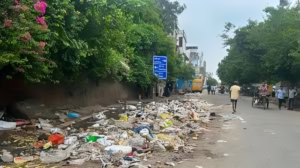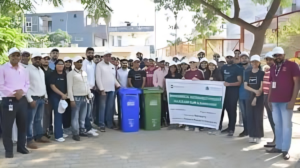Gurugram’s 3‑Day Intensive Clean‑Up Drive Kicks Off for a Greener Tomorrow
––––––––––––––––––––––––––––––––––––––––––––––––––––––––––––––––––––––––––––––––––
Introduction
Gurugram, one of India’s fastest‑growing cities, often struggles with waste piling up in streets and open areas. To tackle this, Haryana government has ordered a three‑day intensive cleaning push across the city. The campaign aims not only to remove litter but also to boost civic sense among residents. In this article, we explore how this drive is planned, who’s involved, and what it means for Gurugram’s future.
––––––––––––––––––––––––––––––––––––––––––––––––––––––––––––––––––––––––––––––––––

––––––––––––––––––––––––––––––––––––––––––––––––––––––––––––––––––––––––––––––––––
Background of the Drive
The idea of a city‑wide intensive clean‑up isn’t new, but this push is special in scale and coordination. Key points:
- Duration: Three consecutive days of non‑stop cleaning, from early morning to late evening.
- Agencies Involved: Municipal Corporation of Gurugram (MCG), private sanitation contractors, local resident welfare associations (RWAs), and school/college volunteers.
- Scope: Main roads, markets, residential pockets, public parks, and water bodies.
Gurugram’s narrow lanes and busy commercial hubs often see plastic waste, discarded packaging, and construction debris. This drive focuses on removing these stubborn pollutants and ensuring proper disposal.
––––––––––––––––––––––––––––––––––––––––––––––––––––––––––––––––––––––––––––––––––
Securing Citizen Participation
A clean city can’t be built by workers alone; citizens play a huge role. To encourage local support:
- Door‑to‑Door Awareness: Volunteers knock on doors, distribute pamphlets in simple English and Hindi, and explain why small efforts (like segregating waste at home) matter.
- Social Media Push: Short videos featuring neighborhood champions encouraging friends to join the clean‑up.
- School Outreach: Students get ‘clean‑up kits’—gloves, masks, and waste bags—and earn community service certificates.
Story from Sector 14: When a group of college students organised a mini‑drive last month, they inspired three nearby RWAs to pitch in. On day two of the main campaign, these associations joined hands with MCG staff to clear a clogged drain that had been neglected for years. Their teamwork cut down the cleaning time by half and brought residents closer.
––––––––––––––––––––––––––––––––––––––––––––––––––––––––––––––––––––––––––––––––––

––––––––––––––––––––––––––––––––––––––––––––––––––––––––––––––––––––––––––––––––––
Key Strategies and Innovations
To make the campaign effective and sustainable, organisers introduced:
1. Smart Tracking of Garbage Trucks
Each vehicle is GPS‑equipped, allowing control rooms to monitor routes in real time. This ensures no area is left untouched and helps with efficient fuel use.
2. Segregation Stations
Temporary drop‑off points where waste is sorted into wet, dry, and hazardous. Trained staff guide citizens on proper sorting, reducing landfill load.
3. Night‑Shift Crews
Some cleaning happens after dusk to target commercial hubs and markets, so daytime traffic remains unaffected.
4. Music and Motivation
Street DJs play upbeat tracks near work zones to lift spirits. Short motivational speeches by local celebrities remind everyone why a tidy Gurugram benefits all.
––––––––––––––––––––––––––––––––––––––––––––––––––––––––––––––––––––––––––––––––––
Challenges and How They’re Overcome
No massive operation is without hiccups. Main hurdles include:
- Traffic Congestion: With narrow lanes and heavy vehicles, cleaning trucks sometimes block roads. Solution: Alternate lane closures and quick‑move teams clear obstacles.
- Public Apathy: A few residents refuse to co‑operate. Solution: Fines for littering announced publicly, paired with reward schemes (vouchers, certificates) for active participants.
- Waste Disposal Backlog: Landfill sites risk overflow. Solution: Partnering with recycling units and composting plants to handle segregated waste on the same day.
––––––––––––––––––––––––––––––––––––––––––––––––––––––––––––––––––––––––––––––––––
Conclusion
Gurugram’s three‑day clean‑up drive is more than a one‑off event. It’s a statement of intent—a push towards a disciplined, eco‑friendly city where citizens and authorities work hand in hand. While trucks, brooms, and volunteers tackle existing mess, the real success lies in lasting behaviour change. If each resident adopts simple habits like using dustbins, separating wet and dry waste, and reporting garbage hotspots, the city will stay cleaner long after the drive ends. Together, Gurugram can shine as a model for urban cleanliness across India.
––––––––––––––––––––––––––––––––––––––––––––––––––––––––––––––––––––––––––––––––––
#TRANDINGNEWS